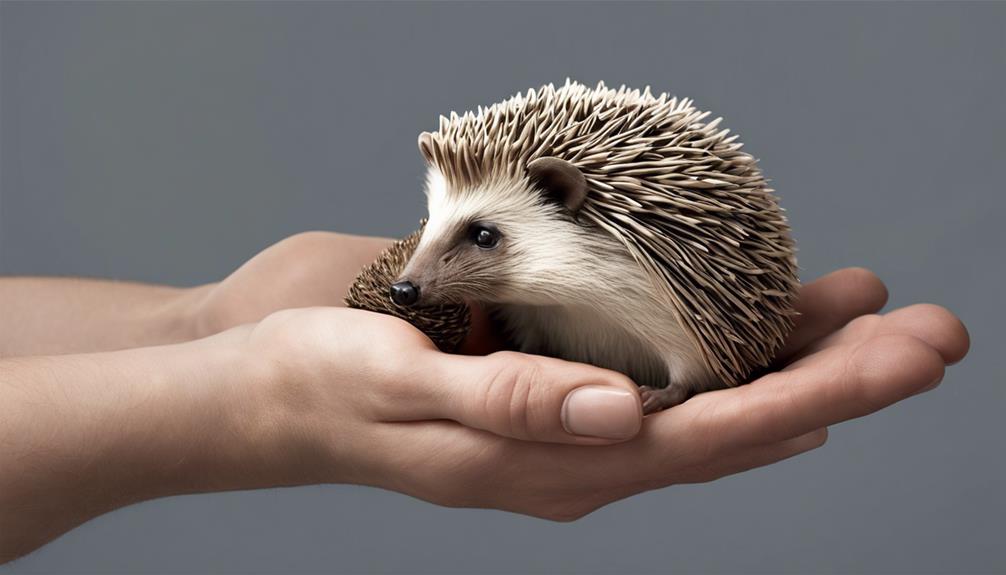Understanding the biting behavior of hedgehogs is important in order to handle them correctly. Hedgehogs may bite when they are experiencing physical discomfort, stress, curiosity, or natural instincts. Signs of aggression such as hissing and defensive behaviors suggest high stress levels. When dealing with bites, it is helpful to be familiar with their behavior and to use gentle deterrents.
Preventing bites involves creating a calm environment and understanding their body language cues. By grasping these insights, we can enhance our interactions with hedgehogs effectively.
Key Takeaways
- Hedgehogs bite with quick, sharp nips using flat teeth.
- Proper handling techniques reduce the likelihood of biting.
- Understanding reasons behind biting behaviors is crucial.
- React calmly and use gentle deterrents to manage bites.
- Addressing biting behavior requires knowing why it occurs.
Reasons Behind Hedgehog Biting Behavior
When examining the reasons behind hedgehog biting behavior, it becomes evident that various triggers can prompt these reactions in these small spiky mammals. Hedgehogs may bite out of physical discomfort, such as during nail trimming or when they're unwell during the quilling process.
Stress-related factors like loud noises, a nervous holder, or lack of rest can also lead to biting behavior in hedgehogs. Additionally, curiosity plays a significant role; behaviors like sniffing scents, licking objects, and exploring new things can sometimes result in hedgehog bites.
Moreover, their natural instincts of discovery and territorial behaviors, including hormonal phases and territorial aggression, may cause them to bite unfamiliar items or individuals during exploration. Understanding these reasons behind hedgehog biting behavior is important for effective prevention and addressing such incidents in the future.
Signs of Aggression in Hedgehogs

Signs of aggression in hedgehogs manifest through behaviors such as hissing, growling, or defensively balling up, indicating potential stress or threat responses. When a hedgehog feels threatened or stressed, it may exhibit bared teeth, raised quills, or even lunge defensively. These signs can escalate to biting, nipping, or snapping if the hedgehog perceives a significant threat. To decrease the chance of getting bitten, it's important to pay attention to their body language. Aggressive behavior can be triggered by unfamiliar scents, loud noises, or sudden movements, so it's important to create a calm and familiar environment for your hedgehog.
If a hedgehog does bite, it's essential not to reinforce that behavior by reacting strongly. Instead, calmly remove yourself from the situation and give your hedgehog space. Understanding the signs of aggression in hedgehogs can help you better anticipate and prevent potential biting incidents. By being attentive to their body language and providing a safe and comfortable environment, you can help keep your hedgehog happy and reduce the likelihood of aggressive behavior.
Handling Hedgehog Bites Effectively
To effectively handle hedgehog bites, understanding the nature of their biting behavior and utilizing appropriate handling techniques is essential for minimizing the risk of being bitten. Hedgehogs typically bite by clamping down with their flat teeth rather than tearing or chewing. Their bites are usually quick, sharp nips rather than prolonged attacks.
It's essential to understand why a hedgehog is biting as it can help in effectively addressing the behavior. Proper handling techniques, such as supporting their body correctly and avoiding sudden movements, can greatly reduce the likelihood of being bitten. Additionally, reacting calmly and using gentle deterrents, like blowing a puff of air near their face or offering a toy as a distraction, can help manage and prevent hedgehog bites effectively.
Strategies for Preventing Hedgehog Bites

Implementing proper husbandry practices is vital in effectively reducing the risk of hedgehog bites. To prevent hedgehog bites, it's important to keep their habitats clean to minimize stress-related biting behaviors. Avoid sudden movements or loud noises that can startle hedgehogs, as this may trigger defensive biting responses. Providing a warm and comfortable environment can also help reduce the likelihood of aggressive behavior and biting incidents.
When handling hedgehogs, remember to do so gently and with care. Building trust through gentle interactions can help minimize the risk of bites. Additionally, offering appropriate toys and enrichment activities can satisfy their natural behaviors and reduce boredom-related biting tendencies.
Understanding Hedgehog Body Language

Understanding hedgehog body language involves observing subtle cues that indicate their emotional state and level of comfort. When interacting with hedgehogs, it's crucial to pay close attention to their body language to guarantee a positive experience for both the hedgehog and yourself.
Here are some key points to take into account:
- Hedgehogs express discomfort or fear through body language cues like hissing, curling into a ball, or spiking up.
- Some hedgehogs may flatten their bodies or raise their quills when feeling threatened or anxious.
- A relaxed hedgehog may have open, relaxed quills and a calm body posture without defensive actions.
- Hedgehogs may exhibit defensive behaviors like clicking teeth or puffing up when feeling stressed or frightened.
- Understanding a hedgehog's body language can help prevent potential bites and improve interactions with them.
Frequently Asked Questions
How Do Hedgehogs Bite?
We bite with flat teeth, crushing rather than sharp. Reasons vary from exploration to defense. Threats, stress, pain, or hormones trigger bites. Understanding helps prevent incidents. Biting communicates discomfort, fear, or need for space.
How Do You Discipline a Hedgehog?
We discipline hedgehogs by utilizing positive reinforcement techniques. It's essential to redirect their behavior and provide a safe environment. Avoid negative punishment; instead, use treats to encourage good habits. Consistency and patience are key for effective discipline.
Does It Hurt When a Hedgehog Bites?
When hedgehogs bite, it usually doesn't hurt much. Their small teeth and gentle jaw strength result in a sensation akin to a pinch. Though minor punctures or scratches can occur, the pain is brief and manageable.
What Is the Behavior of a Hedgehog?
Hedgehogs exhibit a range of behaviors, including defensive responses to threats and territorial aggression when feeling invaded. Communication through nibbling, sniffing, and biting is common. Environmental changes or handling can trigger biting. Understanding these cues helps prevent and address biting incidents effectively.
Can Understanding Hedgehog Behavior Help Us Better Understand Bull Behavior?
Understanding hedgehog behavior can provide valuable insights into why bulls are angry. Both animals have distinct communication signals and social behaviors. By studying hedgehog behavior, researchers can draw parallels to understand the underlying reasons for bull aggression. This cross-species understanding could ultimately lead to better management and handling of angry bulls.
Conclusion
To wrap up, understanding why hedgehogs bite is essential for their proper care and handling. Did you know that hedgehogs have about 5,000 to 7,000 quills on their bodies?
By recognizing signs of aggression, learning how to handle bites effectively, and preventing them through proper care and handling, you can establish a strong bond with your prickly companion.
Stay informed and attentive to your hedgehog's behavior to guarantee a happy and healthy relationship.










